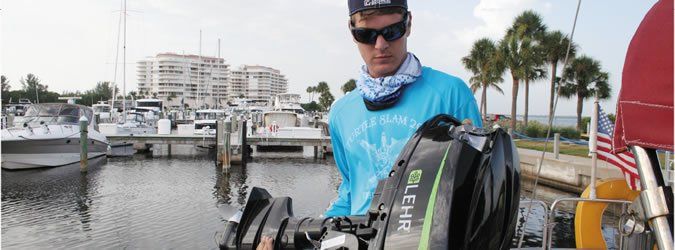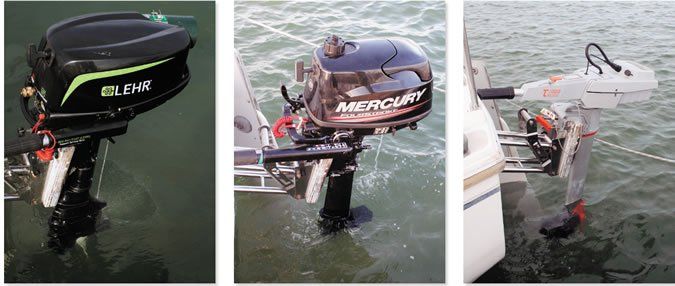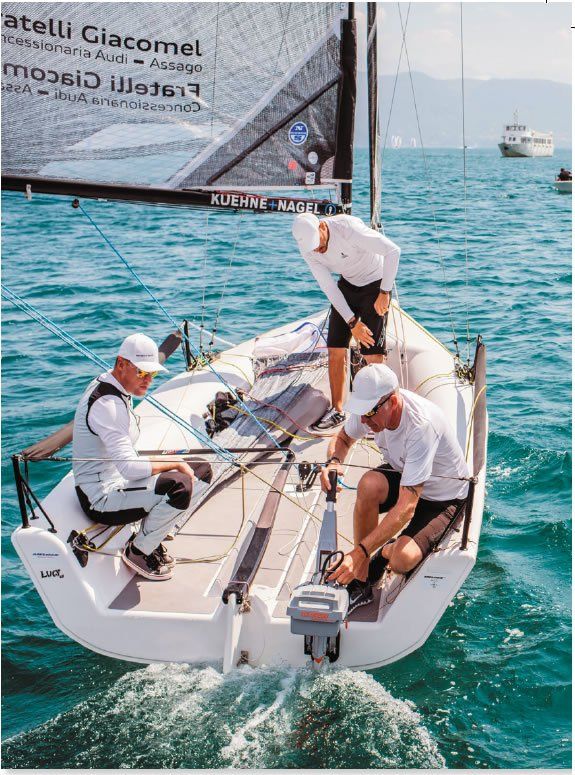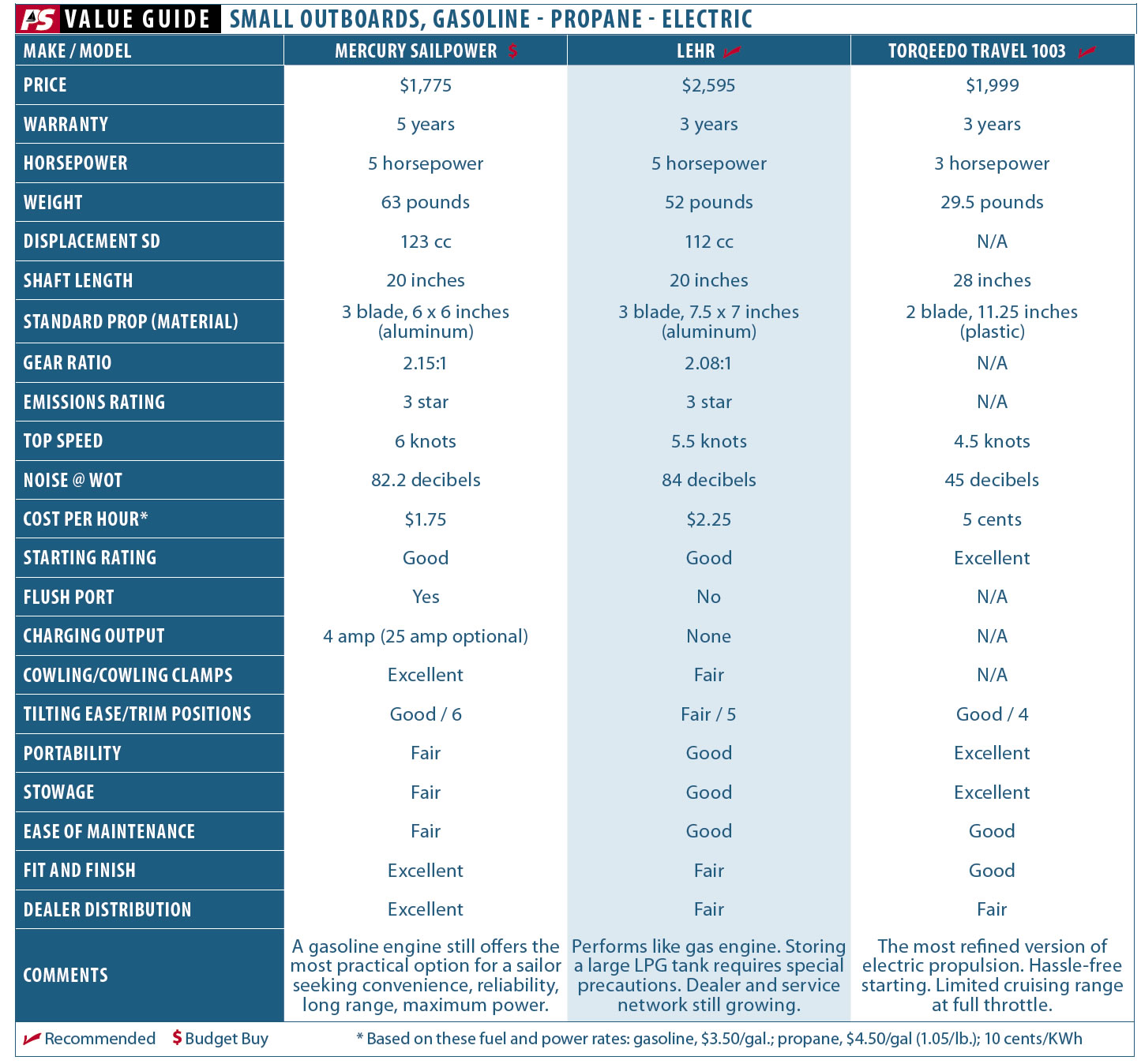Propulsion has long been lingering high on the list of priorities for our trailerable test boat, the Catalina 22 Lil Spitfire. Our first instinct was to go used. We scoured the Internet for a rugged two-stroke like the old Johnson 9.9-horsepower Sailmaster (with electric start) that we loved (and hated) back in the 1980s, but each one was broken or missing a rare part. Although there are still plenty of aficionados who enjoy resurrecting these old engines-Lee Roy Wisner has a website dedicated to the motors, www.leeroysramblings.com-a disheartening glance at our calendar showed no time for messing about with and old blue-smoker. We poked around for a newer motor.
In our last look at small outboards (see PS March 2003), the Tohatsu 9.9-horsepower came highly recommended, but when an energetic intern suggested shed like to race Lil Spitfire with the local Catalina 22 fleet, we decided to look for something smaller and lighter-something that might give her a fighting chance. A bit of research turned up a brand-new Tohatsu 5-horsepower two-stroke weighing just over 40 pounds-but it was in Sydney, Australia. (Apparently, the Aussies havent yet clamped down on two-strokes like we have in U.S.) When the accounting department rejected our eloquent proposal for a trip to Sydney, we were back to square one.

Finding the right outboard for your boat used to be a fairly simple task-decide what horsepower and shaft length you need and go to the nearest dealer. If you were serious, you could fiddle about with propellers, but after the U.S. market switched to four-stroke engines, the distinctions between brands (especially in the lower horsepower ranges) were not that great. As our 2003 report pointed out, the deciding factor was often warranty and local service support. Sailors in harbors with a well-respected Mercury service center bought Mercs, estuaries well-served by a Yamaha guru had a higher proportion of Yamahas . . . and so on. During the last decade, however, small-boat propulsion options have expanded greatly, and depending on ones criteria, some of these new alternatives to small gasoline outboards might be a better fit.
Our own preferences for Lil Spitfire are probably pretty close to the norm for owners of small outboard-powered sailboats (numbering about 38,000 in the United States, according to the latest Coast Guard statistics). We needed enough power to get off the dock on a blustery day and buck tidal currents in cuts. We wanted an engine we could carry without wrenching our back, something we might clamp onto our rowing dinghy, if needed.
Because we had some three- to five-day cruises in Southwest Florida in mind, we thought an alternator would be handy. It would be helpful if we could get a little extra juice to top off the batteries while motor-sailing up the Intracoastal Waterway. Because of this requirement, a four-stroke engine with a small alternator seemed to make the most sense.
But the electric option also appealed to us. No more dealing with oil and gas or yanking on a starter cord. Just twist the throttle and go. If we could get where we wanted to go with a quiet electric motor, wed give up the advantage of a few extra amps from a gasoline engine. Small gasoline outboards put out very few amps anyway.
So long as we were exploring electric motors, we decided to take a closer look at the Lehr engine, which runs on liquefied petroleum gas. We tested a short-shaft Lehr a couple of years ago (see PS February 2015 online), but only as a dinghy engine. We were curious to see how the long-shaft version measured up against its gasoline equivalents.
In this report, the first in a two-part series on portable outboards, we compare the three basic types of motors available to the small-boat sailor today: electric, gasoline, and propane. This installment examines the pros and cons of each type of propulsion. In the second part, well narrow the focus to performance, particularly among the new four-stroke motors.

Electric Propulsion
Practical Sailors interest in modern portable electric propulsion dates back to 2005, when the editor at that time, Doug Logan, began to lose faith in the two-stroke outboard on his 15-foot Boston Whaler. While awaiting the prognosis on his unresponsive 15-horsepower Evinrude, he bought a Minn Kota Riptide 55 trolling motor, thinking it might make a good dinghy engine.
Logans experiments with the Minn Kota focused on its potential as a dinghy motor, but he also tested it on larger skiffs, including the Boston Whaler, which it was able to push at about 3 knots (see PS, Nov. 15, 2005 online). We later heard from several Practical Sailor readers who use trolling motors to power their sailboats (some as large as 30-feet), mainly for short distances and in protected water. Prices on saltwater-rated trolling motors start at around $350 (a 12-volt deep cycle battery to power them adds at least another $120), making the initial costs much less than for other electric motors.
In 2005, we tested four popular trolling motors with rated thrusts ranging from 40 to 80 pounds (see PS May 15, 2005 online). The results highlighted a major drawback of all electric motors: available horsepower and range is contingent upon battery capacity. A half-hour of driving a 2,500-pound, loaded Catalina 22 with one of the more powerful trolling motors at full throttle will leave a standard Group 24 battery gasping. And we knew from experience that we couldnt expect a trolling motor alone to drive Lil Spitfire against a five-knot current. Even with these drawbacks, a trolling motor is a viable option for sailors who just need a little help getting up a canal or off a dock in calm water.
If you need more power, there are other electric alternatives. In our most recent foray into electric outboards, we tested the SolidNav Traveler, a hefty 48-volt, four-horsepower electric outboard. The motor looks nearly identical to a gasoline outboard of the same horsepower, but weighs slightly more. The motor we tested was manufactured by Parsun Power Machine, Chinas largest outboard exporter. The outboards brushless solid magnet motor came from Mars Electrical Co. of Milwaukee, Wis.; the company now is known as Motenergy.
Although the SolidNav brand appears to have disappeared from the market, longtime electric motor manufacturer Elco markets a very similar model for about $3,000. The price does not include the requisite four 12-volt batteries (or equivalent), which can add at least another $1,500-making the initial outlay nearly nine times greater than that for a trolling motor.
Our testers were impressed by the motors heavy-duty design as well as its finish. Incorporating an electric motor into the familiar form factor of a gasoline outboard offers another advantage, it eliminates some of the mounting issues that can crop up when you switch motor types.
The performance of the SolidNav was good, but again, it was limited by the constraints of electric power. In our on-the-water testing of the SolidNav, four North Star Energy group 24 absorbed glass mat (AGM) batteries with 140-amp-hour reserve capacity were wired in series to deliver the required 48 volts. This battery tank delivered about eight miles of range on our test boat (a 19-foot Cape Dory Typhoon) at four knots; this is a good example of how piling on battery capacity extends range.
The problem with the SolidNav is that it does not meet our requirement as portable. It requires a heavy battery installation, which would put it more in the same class as the Torqeedo Cruise models, which deliver far greater range and power than the Travel series we tested.
Of all the portable electric outboards available to the small-boat sailor, the Torqeedo Travel 1003 (starting at about $2,000) holds the most promise. It has been widely accepted in some one-design fleets like the Melges 20, and it clearly has a place among weekend sailors. But in the small sailboat market-which includes many entry-level sailors, or retired cruisers who are pinching every penny-the niche remains rather narrow because of cost. Even if fuel prices were $5 per gallon, it is unlikely that during the projected life of the motors 520 watt-hour (Wh) lithium magnesium battery, a sailboat owner could save in fuel expenses the difference in the initial outlay for the Torqeedo. (See accompanying Value Guide table.) The fact remains that the motors light weight, easy operation and green marketing is what draws its most ardent fans. Keep in mind that how eco-friendly the engine actually is depends on the source of electric power used to charge the batteries.
Although people often compare the Torqeedo Travel 1003 to trolling motors like the Minn Kota, there are several key differences. The Torqeedos lithium-magnesium battery has a longer life and a more favorable power-to-weight ratio than a lead-acid battery. The Torqeedos brushless motor design is more reliable and better suited for continuous duty. Its rechargeable battery has a smart battery management system that monitors cycling to help prolong life. The battery even meets IPX67 standard, meaning it can be immersed one meter of water for at least 30 minutes without any harm.
This is the third time weve looked at Torqeedos Travel series motors. In our first preview, we tested an early iteration of the Travel 801L (see PS November 2007 online), an ultralight electric equivalent of a two-horsepower outboard. Four years ago, we tested the more powerful Torqeedo Travel 1003. In that test, we pitted the Travel 1003 against the Electric Paddle, an ultralight portable electric motor that looks like a trolling motor but has a larger diameter prop and its own rechargeable battery (see PS January 2011 online).
With 30 percent more battery power than the 801, plus greater thrust and efficiency, the Travel 1003L (long shaft) has proven impressive on a variety of test boats, including a round-bilge carbon-fiber dinghy from Wing Systems, a Cape Dory Typhoon, a 10-foot Dynamic RIB from Mercury, a Venture 22, and our Catalina 22.
As with all electric motors, power and range are limited. On the Catalina 22, the range on a single battery at 4 knots is about 2.5 miles. At about 2.5 knots, the maximum range is about eight miles. Circumnavigator and sailing writer Webb Chiles reports getting similar numbers on his Moore 24, which is nearly the same weight.
Because it is so light (less than 30 pounds), the Travel 1003 is truly portable, and a good option for people who transport their engine frequently.
We were particularly happy with its performance on the various dinghies. Maximum speed on the Wing Systems dinghy was about seven knots, but that could only be sustained for about a half-hour. At slower speeds, range approaches 10 miles-which is plenty of out-and-backs to shore.
Bottom line: For daysailers up to about 2,000 pounds, a portable electric motor is a viable option, but longer range and more power will require significant investment for big battery banks-and this would no longer qualify it as portable in our books. The limited range of the Torqeedo wont matter for the lake sailor who just needs the occasional short boost home when the wind dies. And for extended range, the owner can always invest in another battery without compromising portability. For portable electric propulsion, the Torqeedo is the most convenient and best suited option in our view, but for the budget-minded small-boat sailor tired of the hassles of gasoline power, a trolling motor will also work within certain limits.
LPG vs. Gasoline
More than a few cruising sailors still long for the days of the lightweight two-stroke outboard engines. Though they are noisy, smelly, and dirty, two-stroke motors in the six-horsepower range weigh about 18 pounds lighter than the four-stroke outboards in our comparison. Whether you are hefting them onto a dinghy or daysailer, those 18 pounds make the difference between an engine that is truly portable and one that requires a nephew with a gym membership to muscle into place.
Although the four-stroke outboards in the 100-horsepower-and-up range are measurably lighter compared to earlier models from the 1990s, there are only so many ounces you can pare from a five-horsepower outboard without it becoming too fragile or expensive. More than anything, the lighter weight is what attracted us to the five-horsepower Lehr propane outboard. The long-shaft version that we tested tips the scales at 53 pounds, about 10 pounds less than the other long-shaft outboards we tested.
The Lehr is not simply a gas-to-LPG retrofit. It replaces the conventional fuel delivery system with a purpose-designed LPG system. You can either screw a 16-ounce camp-type LPG canister into the back of the engine, or use an adapter hose to connect the engine to a larger tank, such as the 20-pound tanks used to fire a barbecue or onboard stove. A simple needle valve controls the fuel flow-one of the reasons you are supposed to remove the fuel tank when it is not in use.
The lighter weight and the prospect of not having to worry about a gummed-up carburetor or ethanol damage were other features that attracted us to the Lehr. During the 18-month trial period, the Lehr engine always cold-started on three to seven pulls, and it was nice not to have to go through the storage hassles associated with gasoline-powered outboards.
In terms of performance, the Lehr was able to push our Catalina 22 along at 5.5 knots at wide open throttle, putting it in the middle of the pack among the five- and six-horsepower gasoline engines we tested. At this speed, it was a little noisier than some of the four-stroke gasoline outboards in our test, and it is not available with a charging system.
The one thing that surprised was the fuel costs. Although the differences in fuel consumption rates among similar-horsepower gas engines are too small to quibble over, the differences in efficiency and the price of LPG (at least in our local area) makes fuel economy relevant here. In our testing, Lehr was less fuel-efficient than the more powerful six-horsepower Mercury at wide-open throttle, but the consumption rates (about .5 gallons per hour) were close enough to compare at one-to-one. Our local LPG service center, Flanders Gas, refills our 20-pound tank (4.7 gallons) for $21. With gasoline prices hovering around the $3 range and LPG selling for nearly $4.50 per gallon, we were spending 50 percent more per hour to run propane engine. Of course, fuel prices fluctuate, so LPG may one day be more economical, but right now-at least not in our neighborhood-it isn’t.
Another drawback to the engine is finding a service center for it. Although the Lehr is relatively simple and shares many of the same readily available parts as conventional outboards, getting authorized warranty service requires calling Lehr to track down the nearest service center. Right now, there are only a limited number service centers in the U.S. The complications of owning a propane engine begin to compound if you are traveling abroad, where the LPG fill stations are more widely scattered. The 16-ounce Coleman camp-style canisters are hardly ubiquitous in the islands, and once you hit French territories in the Caribbean, the larger propane canisters have different fuel fittings, requiring an adapter.
From a practical standpoint, the Lehrs biggest advantages are its lighter weight and the fact that it is immune to many of the problems associated with gasoline fuel system. However, one of its most highly promoted features is that it is more environmentally friendly than gasoline. Lehr claims its engines reduce carbon emissions by 65 to 70 percent. (Other sources indicate reductions of about 20 to 30 percent.)
Even if one were to accept Lehrs numbers, switching for purely for environmental reasons-whether to electric or propane-is worth reflecting on. After all, a sailboats auxiliary engine accounts for very few total emissions to begin with. If a significant reduction in your carbon footprint is your true aim, a set of oars is the way to go.
Bottom line: If electric propulsion does not offer the range or power that you need for your sailboat, the propane option is certainly viable in places such as the United States, where LPG is readily available and relatively inexpensive. We Recommend it for the eco-conscious sailor who needs a powerful outboard but wants to reduce his carbon footprint. It also is a good choice for a sailor who wants to trim a few pounds from the stern, and likes the idea of not having to mess with gasoline.

Conclusion
A four-stroke outboard is hardly perfect, but for our requirements, it was the best suited for the task. As much as we dislike the hassles of ferrying fuel to and from the boat, changing the oil, and ensuring the motor will start again after a long layover, the advantages of a four-stroke gasoline outboard were too hard for us to resist. From a practical standpoint, a gasoline-powered outboard is a more sensible choice for the sailor whose first priorities are maximum power, reliability, and service support.
However, during the course of our testing, it became obvious that many sailors will find electric or LPG propulsion better suits their own needs. In the end, your budget and how you use the boat will be the determining factor.
In part two of this article, well compare the performance of three popular four-stroke outboards and take a closer look at the performance of the Lehr and the Torqeedo Travel 1003.







































